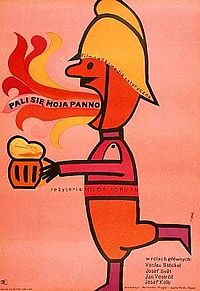- Czechoslovak New Wave
-
Czechoslovak New Wave 
Polish poster of Firemen's Ball by Miloš FormanYears active 1960s Country Czechoslovakia Major figures Miloš Forman, Jiří Menzel, Věra Chytilová, Ivan Passer, Jan Němec, Jaromil Jireš Influences Devětsil, political liberalization of Czechoslovakia leading up to the Prague Spring The Czechoslovak New Wave (also incorrectly Czech New Wave) is a term used for the early films of 1960s Czech directors Miloš Forman, Věra Chytilová, Ivan Passer, Jaroslav Papoušek, Jiří Menzel, Jan Němec, Jaromil Jireš, Vojtěch Jasný, Evald Schorm and Slovak directors Juraj Herz, Juraj Jakubisko, Štefan Uher, Ján Kádár, Elo Havetta and others. The quality and openness of the films led the genre to be called the Czechoslovak film miracle.
Contents
Overview
The Czechoslovak New Wave was an artistic movement in cinema which evolved out of the earlier Devětsil movement of the thirties. Disgruntled with the communist regime that had taken over in Czechoslovakia in 1948, students of the Film and TV School of The Academy of Performing Arts in Prague (also known as FAMU) became the dissenters of their time. Their objective in making films was "to make the Czech people collectively aware that they were participants in a system of oppression and incompetence which had brutalized them all."[1]
Trademarks of the movement are long unscripted dialogues, dark and absurd humour, and the casting of non-professional actors. The films touched on themes which for earlier film makers in the communist countries had rarely managed to avoid the objections of the censor, such as the misguided youths of Czechoslovak society portrayed in Miloš Forman's Black Peter (Czech: Cerný Petr 1963) and Loves of a Blonde (Lásky jedné plavovlásky 1965), or those caught in a surrealistic whirlwind in Věra Chytilová's Daisies (Sedmikrásky 1966) and Jaromil Jireš' Valerie and Her Week of Wonders (Valerie a týden divů 1970).
The Czechoslovak New Wave differed from the French New Wave in that it usually held stronger narratives, and as these directors were the children of a nationalized film industry, they had greater access to studios and state funding. They also tended to present films taken from Czech literature, including Jaromil Jireš' adaptation of Milan Kundera's anti-Communist novel The Joke (Žert 1969). At the Fourth Congress of the Czechoslovak Writers Union in 1971, Milan Kundera himself described this wave of national cinema as an important part of the history of Czechoslovak literature.[2] Forman's The Firemen's Ball (Hoří, má panenko 1967), another major film of the era, remains a cult film more than four decades after its release.
As Alexander Dubček came to power over the Communist Party in Czechoslovakia with plans to present "socialism with a human face" through reform and liberalization (a brief period known as the Prague Spring), the Soviet Union and their Warsaw Pact allies invaded to snuff out reform. The movement came to an abrupt end and Miloš Forman and Jan Němec fled the country, while those who remained faced censorship of their work.
Czech film
The majority of films shot during the New Wave were Czech-language as opposed to Slovak. Many directors came from the prestigious FAMU, located in Prague, while the state-run Barrandov Studios were located just on the outskirts of Prague. Some prominent Czech directors included Miloš Forman, who directed The Firemen's Ball, Black Peter, and Loves of a Blonde during this time, Věra Chytilová who is best known for her film Daisies, and Jiří Menzel, whose film Closely Watched Trains (Ostře sledované vlaky 1966) won an academy award for best foreign language film.
Slovak film
The Shop on Main Street (Obchod na korze 1965) directed by Ján Kadár and Elmar Klos won the academy award for best foreign language film in 1966. It takes place in Slovakia during World War II and tells the story of a poor Slovak man named Anton "Tono" Brtko who is given a job by the local fascist regime to be the "Aryan owner" of a button shop run by an elderly Jewish woman.
Key works of the Czechoslovak New Wave
- The Sun in a Net by Štefan Uher (1962)[3][4]
- Something Different by Věra Chytilová (1963)
- Black Peter by Miloš Forman (1963)
- The Fifth Horseman is Fear by Zbynek Brynych (1964)
- Loves of a Blonde by Miloš Forman (1965)
- The Shop on Main Street by Ján Kadár and Elmar Klos (1965)
- Pearls of the Deep by Jiří Menzel, Jan Němec, Evald Schorm, Věra Chytilová, Jaromil Jireš (1966)
- Closely Watched Trains by Jiří Menzel (1966)
- Daisies by Věra Chytilová (1966)
- The Firemen's Ball by Miloš Forman (1967)
- Deserters and Pilgrims (aka The Deserter and the Nomads) by Juraj Jakubisko (1968)
- The Joke by Jaromil Jireš (1968)
- All My Compatriots by Vojtěch Jasný (1968)
- The Gala in the Botanical Garden by Elo Havetta (1969)[5]
- Birds, Orphans and Fools by Juraj Jakubisko (1969)
- Behold Homolka by Jaroslav Papoušek (1969)
- Case for a Rookie Hangman by Pavel Juráček (1970)
- Valerie and Her Week of Wonders by Jaromil Jireš (1971)
See also
References
Further reading
- Cook, David (1996). A History of Narrative Film.
- Hames, Peter: The Czechoslovak New Wave (Berkeley, Los Angeles, London 1985)
- Škvorecký, Josef: All The Bright Young Man and Women: A Personal History of the Czech Cinema (Toronto 1971)
External links
- Jan Němec: Enfant Terrible of the Czech New Wave by Peter Hames
- Slovak Cinema Strikes Back by Peter Hames
- History of Czech film
- The Czechoslovak New Wave on Criterion Collection: a thorough overview
Categories:- Cinema of the Czech Republic
- Cinema of Slovakia
- New Wave in cinema
Wikimedia Foundation. 2010.
